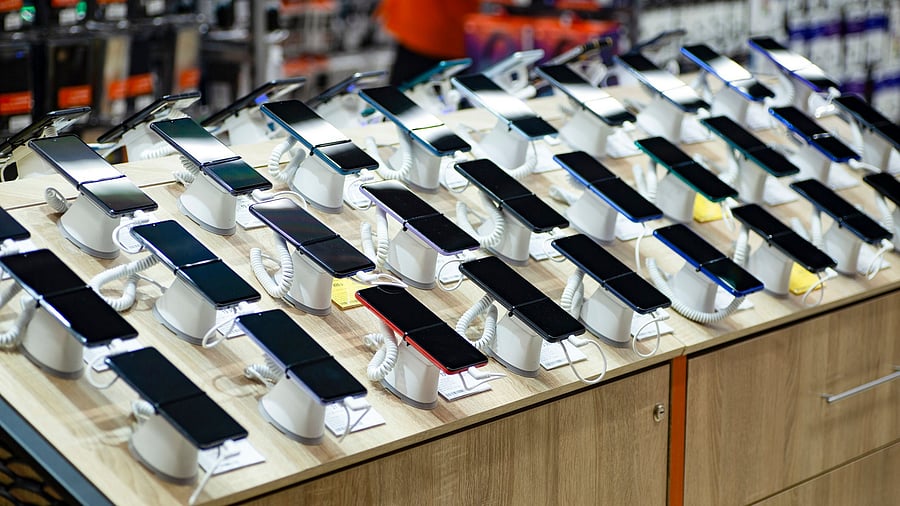
Representative image showing smartphones in a store
Credit: iStock Photo
India may be a thriving producer and exporter of electronic goods, especially smartphones, but it remains a relatively minor player in world markets.
It has now entered the list of top 10 exporting nations, but has a long way to go to catch up with the leaders like China and South Korea. This is despite the electronics industry growing leaps and bounds over the past decade. Domestic output of electronics has risen from Rs 1.9 lakh-crore in FY2015 to Rs 9.52 lakh-crore in FY2024, recording an annual growth of 17.5% over this period.
Similarly, smartphone exports were zero in 2016, but have now touched Rs 1.82 lakh-crore ($21 billion) in the first 11 months of 2024-2025 (April to February). Imports, on the other hand, now meet only 4% of local demand compared to 75% in 2014. In other words, smartphones used by Indians are now mostly made within the country.
Against this backdrop of burgeoning growth, the government is reported to be considering a massive initiative to boost domestic production of electronic components. It envisages an outlay of Rs 23,000 crore over a six-year period. The aim is to raise domestic value addition in a wide array of electronic products from the current level of only 15-20% to about 40%. Among the items which could be included under the scheme are display modules, sub-assembly camera modules, and printed circuit board assemblies.
The launch of such a programme must be welcomed but one can only wonder at the reasons for the delay in formulating such a vital measure. The fact that finished electronic products have a rather low level of indigenous value addition has been known for quite a while. Even the latest Economic Survey commented that the industry has largely focused on assembly with limited progress in design and component manufacturing.
Whether in smartphones or other electronic goods, the domestic component has remained at only 15-20%. The output of finished goods by domestic factories, in contrast, has risen exponentially. But this has primarily been in the form of assembly line production using components coming from the rest of the world. The result is, finished phones may no longer be imported in huge numbers but the parts and accessories needed to make them still must be brought into the country. It is no surprise then that electronics components have emerged as the second biggest item in the country’s import basket, next only to crude oil.
What should also be of deep concern is that many of these components come from China. It would not be possible to eliminate such imports entirely. But an effort can be made to reduce the existing heavy reliance on supplies from the eastern neighbour. The only way to do so is by raising domestic production capacities.
The other route of regulating imports has been tried in the case of laptops and prompted a backlash from leading global tech companies. The proposal was initially made in 2023 in a bid to reduce the level of laptops being sourced from China. But it was rightly viewed as a broader protectionist measure prompting even the United States Trade Representative to raise the issue with counterparts in Delhi. The regulatory plan thus evolved into a simple registration scheme for laptop imports.
On the US tariff issue, however, the electronics industry is prepared to deal with the reciprocity in rates. In fact, domestic manufacturers are urging the government to agree to the Trump administration’s demands to bring down tariff walls in this country. The reasoning is interesting. Duties on most consumer electronics here are 16.5% compared to 0.6% in the US. If reciprocal tariffs are sought at existing rates, Indian goods would face stiff competition in the huge US market, especially from countries like Vietnam. So, the preference is for India to cut duties to bring about parity. Easier imports of such goods from the US would apparently have a minimal impact on domestic industry.
The outlook for the indigenous electronics sector is, therefore, promising as production has nearly doubled from $48 billion in FY2017 to $101 billion in FY2023. But hard work is needed to catch up with the big boys in global markets. Growth in this sunrise industry has been given an impetus by the China-Plus-One policy, that is, making parallel investments in other Asian economies.
The advent of Apple’s collaborators in India, for instance, has been a major factor behind the recent skyrocketing pace of smartphone exports. Policymaking needs to be nimble to keep pace with these developments. Otherwise, India will lose out to its canny competitors in neighbouring Southeast Asia.
(Sushma Ramachandran is a senior journalist.)
Disclaimer: The views expressed above are the author's own. They do not necessarily reflect the views of DH.